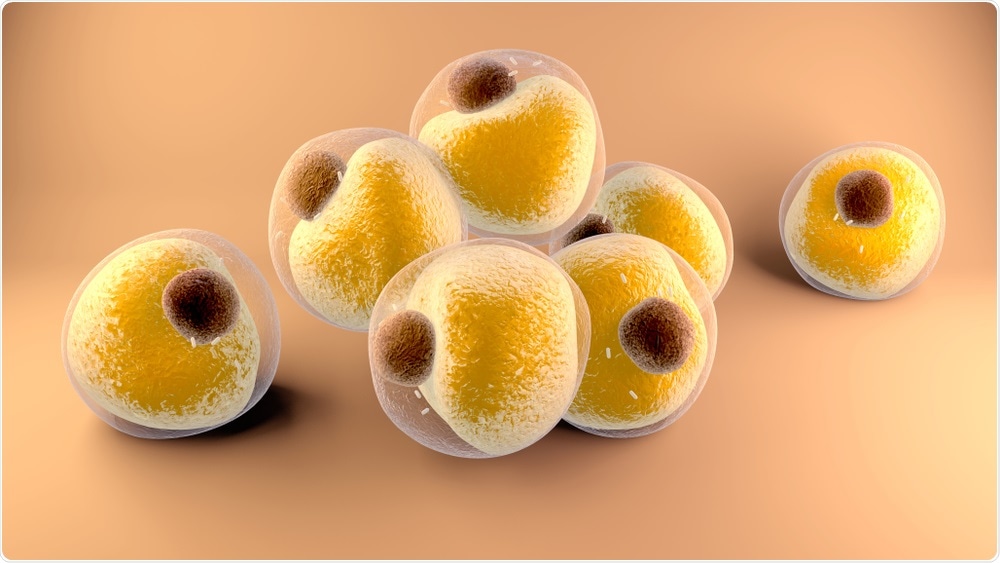The fat cells of the body play an essential role in the storage of energy and its release when necessary. Research has shown that apart from energy storage, these adipocytes or fat cells also play a role in hormonal balance and metabolism-regulating hunger. A new study titled, “Systems-genetics-based inference of a core regulatory network underlying white fat browning”, was published in the latest issue of the journal Cell Report.

Image Credit: Design_Cells/Shutterstock.com
Fat Cells
A new study has shown that genes play a role in the browning of white fat in the body. There are three types of fat cells within the body say, experts – white, brown and beige/brite. White fat cells mainly store energy, while brown and beige fat cells can convert the energy stored within them into heat. Brite cells are commonly found in the inguinal region of the body around the genitalia. This is called non-shivering thermogenesis, therefore, brown fat is vital for certain mammals and newborn human babies in preserving the body heat, maintaining the temperature at stable levels.
According to lead author of the study, Professor Klingenspor, Chair of Molecular Nutritional Science at the TUM Else Kröner-Fresenius Center, “Adipocytes are not merely an energy storage for times of deprivation, but they also release hormones into the blood, regulating our metabolism as well as feelings of hunger and satiety through the brain and other organs. Nevertheless, too much of a good thing causes harm.” He went on to explain that different people have varying levels of brown and beige fat cells and those with a high number of brown fat cells have a smaller risk of becoming obese and developing metabolic disorders. Some individuals, he explained may develop beige fat cells within the white fat cells and this can provide health benefits. This is termed as brite adipogenesis, he said.
Browning of fat cells
This new study shows a genetic difference among those with more browning of white fat. Klingenspor added, “We want to understand how thermogenic fat cells develop; so how beige fat cells grow inside white fat tissue.” He explained that as white fat cells are converted into beige ones, they transform from an organ that stored energy, to become an organ that can spend the energy in the form of heat, thus improving the metabolism reducing the risk of metabolic diseases and obesity.
The study
For this study, the team included lab mice with genetic specificities enabling different regions of their genes to be stimulated or suppressed. For this study 5, inbred mice strains were taken – SWR/J, BL/6J, 129S6, A/J and AKR/J. The presence and color of the fat cells were compared, the researchers explained. This was then correlated with the genes of the mice. Klingenspor said, “By systematically comparing fat cells among these different strains of mice, we were able to discover which genes or regulators might explain the variation in beige cell differentiation - in other words, the growth of beige fat cells.” They also used in vitro models and insulin sensitizer drug rosiglitazone to look at the effects of browning of fat cells.
Once the fat cells were determined, the genetic sequence of the mice was outlined using the Next Generation Sequencing technology and the TUM/EPFL team explored the entire genome of the mice using their tools. This is called transcriptomics meaning the genetic makeup of the animal and the protein-coding by the genes. Among the genetically different mice complexes, the transcriptomic analysis was performed to pinpoint the genetic factors that influenced fat cell distribution. This team became the first researcher group to have identified a set of genes and their effects of browning on existing white fat cells.
Results
The authors concluded that from the results, several physiological properties help browning of the fat within the body. Application of a genetic model could help determine the different mutations and alterations in the genes helping in brite adipogenesis or browning of white fat cells, wrote the researchers. They wrote in their conclusion that “in vitro and in vivo models provide complementary genetic systems that can be employed to identify genes that are critical for the induction of the browning program in progenitor cells…”
Klingenspor explained the next steps in this research saying, “Now we have gathered a unique insight into the genetic architecture driving the molecular mechanisms of beige fat cell development. What we managed to confirm in cell culture is now to be examined 'in vivo' - so inside a living organism - as our next step.”
Journal reference:
Li, Y., Schwalie, P., Bast-Habersbrunner, A., Mocek, S., Russeil, J., Fromme, T., Deplancke, B. and Klingenspor, M. (2019). Systems-Genetics-Based Inference of a Core Regulatory Network Underlying White Fat Browning. Cell Reports, 29(12), pp.4099-4113.e5.